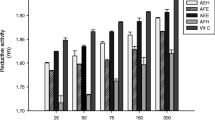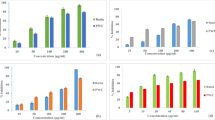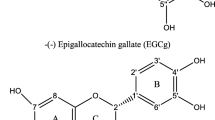Abstract
Electron spin resonance (ESR) spin trapping was utilized to investigate the scavenging effects on hydroxyl radicals (·OH) and superoxide radicals (O2·-) by (-)-epigallocatechin-3-gallate (EGCG), one of the major anticancer compounds in tea. The spin trap used was 5,5-dimethyl-pyrroline N-oxide (DMPO). The Fenton reaction (Fe2+ + H2O2→ Fe3+ +·OH + OH-) was used as a source of ·OH radicals. EGCG efficiently scavenges ·OH radicals with reaction rate of 4.62 × 1011 M- 1sec- 1, which is an order of magnitude higher than several well recognized antioxidants, such as ascorbate, glutathione and cysteine. It also scavenges O2·- radicals as demonstrated by using xanthine and xanthine oxidase system as a source of O2·- radicals. Through its antioxidant properties, EGCG exhibited a protective effect against DNA damage induced by Cr(VI). EGCG also inhibited activation of nuclear transcription factor NF-κB induced by Cr(IV) and 12-o-tetradecanoylphorbol-13-acetate (TPA). The present studies provide a mechanistic basis for the reported anticarcinogenic properties of EGCG and related tea products.
Similar content being viewed by others
References
Yang CS, Wang ZY: Tea and cancer. J Natl Cancer Institute 85: 1038-1049, 1993
Yang CS, Lee M, Chen L, Yang G: Polyphenols as inhibitor of carcinogenesis. Environ Health Perspect 105: 971-976, 1997
Stagg GV, Millin DJ: The nutritional and therapeutic value of tea–a review. J Sci Food Agric 26: 1439-370, 1975
Komori A, Yatsunami J, Okabe S, Abe S, Hara K, Suganuma M, Kim S, Fujiki H: Anticarcinogenic activity of green tea polyphenols. Jpn J Clin Oncol 23: 186-190, 1993
Wang Z, Hong J, Huang M, Reuhl KR, Coney AH, Yang CS: Inhibition of N-nitrosodiethylamine and 4-(methylnitrosamino)-1-(3-pyridyl)-1-butanone-induced tumorigenesis in A/J mice by green tea and black tea. Cancer Res 52: 1943-1947, 1992
Wang ZY, Cheng SJ, Zhou ZC, Athar M, Khan WA, Bickers DR, Muhktar H: (1989) Antimutagenicity of green tea polyphenols. Mutat Res 233: 273-285, 1989
Xu Y, Ho CH, Amin SG, Han C, Chung FL: Inhibition of tobaccospecific nitrosamine-induced lung tumorigenesis in A/J mice by green tea and its major polyphenol as antioxidants. Cancer Res 52: 3875-3879, 1992
Salah N, Miller NJ, Paganga G, Tijburg L, Bolwell GP, Rice-Evans C: Polyphenolic flavanols as scavengers of aqueous phase radicals and as chain-breaking antioxidants. Arch Biochem Biophys 322: 339-346, 1995
Nanjo F, Goto K, Seto R, Suzuki M, Sakai M, Hara Y: Scavenging effects of tea catechins and their derivatives on 1,1-diphenyl-2-picrylhydrazyl radical. Free Radical Biol Med 21: 895-902, 1996
Guo Q, Zhao B, Li M, Shen S, Xin W: Studies on protective mechanisms of four components of green tea polyphenols against lipid peroxidation in synapotosomes. Biochim Biophys Acta 1304: 210-222, 1996
Aust SD, Chigell CF, Bray TM, Kalyanaraman B, Mason RP: Free radicals in toxicology. Toxicol Appl Pharmacol. 120: 168-178, 1993
Stohs SJ:The role of free radicals in toxicity and disease. J Basic Clin Physiol Pharmacol 6: 205-228, 1995
Yoshizawa S, Horiuchi T, Fujiki H, Yoshida T, Okuda T, Sugimura T: Antitumor promoting activity of (1)-epigallocatechin gallate, the main constituent of “tannin” in green tea. Phytother Res 1: 44-47, 1987
Janzen EG, Blackburn BJ: Detection and identification of shortlived free radicals by an electron spin resonance trapping technique. J Am Chem Soc 90: 5909-5910, 1968
Ye J, Ghosh P, Cippitelli M, Subleski J, Hardy KJ, Ortaldo JR, Young HA: Characterization of a silencer regulatory element in the human interferon-γ promoter. J Biol Chem 269: 25728-25734, 1994
Buettner GR: ESR papameters of spin adducts. Free Radical Biol Med 3: 259-303, 1987
Shi X, Dalal NS: Chromium(V) and hydroxyl radical generation during the glutathione reductase-catalyzed reduction of chromium(VI). Biochem. Biophys Res Commun 163: 627-634, 1989
Morehouse KM, Mason RP: The transition metal-mediated formation of the hydroxyl free radical during the reduction of molecular oxygen by ferredoxin-NADP+ oxidoreductase. J Biol Chem 263: 1204-1211, 1988
Flinkelstein E, Rosen GM, Rauckman EJ: Spin trapping. Kinetics of the reaction of superoxide and hydroxyl radicals with nitrones. J Am Chem Soc 102: 4994-4999 1980
Buettner GR: The spin trapping of superoxide and hydroxyl radicals. In: LW Oberley(ed). Superoxide Dismutase, Boca Raton, FL: CRC press, 1982, pp 64-81
Marriott PR, Perkins MJ, Griller D: Spin trapping for hydroxyl radical in water: A kinetics evaluation of two popular traps. Can J Chem 58: 803-807, 1980
Shi X, Ding M, Ye J, Wang S, Leonard SS, Zang L, Castranova V, Chiu A, Dalal NS, Liu K: Cr(VI) causes activation of nuclear transcription factor-κB, DNA strand breaks and dG hydroxylation via free radical reactions. J Inorgan Biochem 1999 (in press)
Schreck R, Albermann K, Baeuerle PA: Nuclear factor-κB: an oxidative stress-responsive transcription factor of eukaryotic cells (a review). Free Radical Res Commun 17: 221-237, 1992
Shi X, Dalal NS: On the hydroxyl radical formation in the reaction between hydrogen peroxide and biologically generated chromium(V) species. Arch Biochem Biophys 277: 342-350, 1990
Block G: The data support a role of antioxidants in reducing cancer risk. Nutr Rev 50: 207-213, 1992
Dorfman LM, Adams GE: Reaction rates of hydroxyl radical with various substances. Natl Ref Data Ser, Natl Bur Stand (US), No. 46, pp. 1-56, 1983
Ye J, Zhang X, Young HA, Mao Y, Shi X: Chromium(VI)-induced nuclear factor-κB activation in intact cells via free radical reactions. Carcinogenesis 16: 2401-2405, 1995
Katiyar SK, Agarwal R, Wood GS, Mukhtar H: Inhibition of 12-O-tetradecanoylphorbol-13-acetate-caused tumor promotion in 7,12-dimethylbenz[a]anthracene-initiated SENCAR mouse skin by a polyphenolic fraction isolated from green tea. Cancer Res 52: 6890-6897, 1992
Shi X, Mao Y, Knapton AD, Ding M, Rojanasakul Y, Gannett PM, Dalal NS, Liu K: Reaction of Cr(VI) with ascorbate and hydrogen peroxide generates hydroxyl radicals and causes DNA damage: role of Cr(IV)mediated Fenton-like reaction. Carcinogenesis 15: 2475-2478, 1994
Liu KJ, Shi X, Jiang JJ, Goda F, Dalal NS, Swartz HM: Chromateinduced chromium(V) formation in live mice and its control by cellular antioxidants: an L-band EPR study. Arch Biochem Biophys 323: 33-39, 1995
Shi X, Chiu A, Chen CT, Halliwell B, Castranova V, Vallyathan V: Reduction of chromium(V) and its relationship to carcinogenesis. J Toxicol Environ Health 2: 101-118, 1999
Author information
Authors and Affiliations
Rights and permissions
About this article
Cite this article
Shi, X., Ye, J., Leonard, S. et al. Antioxidant properties of (-)-epicatechin-3-gallate and its inhibition of Cr (VI)-induced DNA damage and Cr (IV)- or TPA-stimulated NF-κB activation. Mol Cell Biochem 206, 125–132 (2000). https://doi.org/10.1023/A:1007012403691
Issue Date:
DOI: https://doi.org/10.1023/A:1007012403691




